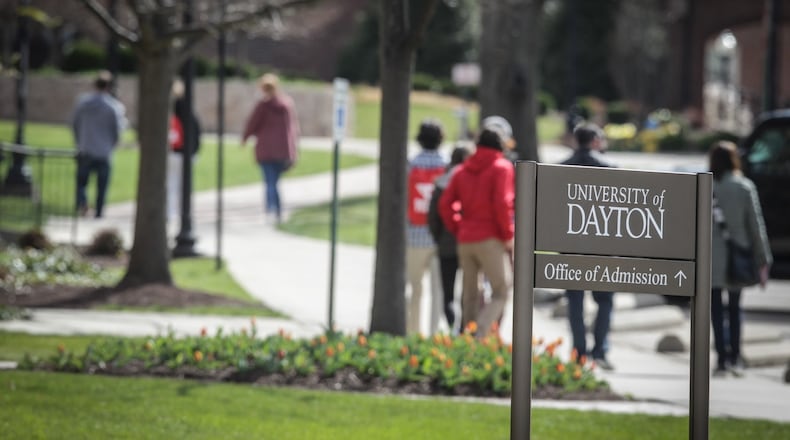Local and state universities varied widely in new freshman enrollment for 2020-21.
** University of Dayton officials said their first-year enrollment last fall of about 2,150 students was up 9% from 2019 (which was a slight aberration year) and was consistent with the 2018 and 2017 numbers.
** Wright State’s “direct from high school enrollment” fell from 1,603 in fall 2019 to 1,352 in fall 2020, according to director of communications Seth Bauguess, marking a 15.7% drop. That continues a multi-year negative trend.
** At Ohio State University, the number of “new first-year students” on the Columbus campus increased 12.7% from 7,630 to 8,602 for fall 2020, offsetting declines in transfer and returning students, as the university’s overall enrollment stayed roughly flat. OSU director of media relations Ben Johnson said student applications, which were at 52,015 and 53,313 the past two years, rocketed to 63,121 this year.
** Wilmington College had an 8.4% drop in new high school graduates enrolling last fall, from 345 down to 316. But senior director of public relations Randy Sarvis said 14 students who took a “wait-and-see” approach ended up enrolling in January, cutting that drop in half.
“Competition for direct-from-high-school students among Ohio’s institutions of higher education has never been greater,” Bauguess said, pointing to both short-term COVID concerns and long-term declines in Ohio’s youth population. “Our focus at Wright State has been to double-down on our commitment to (these) students who, at this time, may require more support as they enter college than previous classes.”
Community colleges
Nationally, the Clearinghouse data showed that immediate enrollment from high school dropped 3.0% at public four-year colleges, 5.2% at private four-year schools, and 13.2% at community colleges.
Sinclair Community College officials said they saw an 11% decrease in straight-from-high-school enrollment in 2020. But because the school serves a diverse range of residents, overall headcount enrollment (18,742) dipped by only 1%, according to the Ohio Department of Higher Education.
Sinclair’s headcount enrollment is actually up by a fraction of a percent from 2015 to 2020, making it one of only five Ohio community colleges (out of 23) to see an increase in that period, according to ODHE.
Cathy Petersen, Sinclair’s chief of public information, said community college enrollment is largely connected to unemployment rates — the school’s record enrollment came in 2010-12 as the Great Recession sent people back to school for additional training to compete for jobs.
Now Sinclair is adjusting again, in the wake of a COVID-affected year, she said.
“Institutions, including Sinclair, will adapt to providing multiple course and program options online, in-person, or a combination,” Petersen said. “Online program offerings at Sinclair College expanded by 60% in 2020 (to 59 fully online programs). In 2021, we anticipate this number to grow by an additional 15-20 programs.”
In Piqua, Edison State Community College took the giant step of waiving tuition for qualifying 2021 high school graduates who enroll in the first year after graduation, calling it “an investment for long-term enrollment.”
Long-term trend
While last fall’s national enrollment decline was four times larger than the year before, in general, higher education enrollment at Ohio public colleges has been declining for years.
Data from the Ohio Department of Higher Education shows enrollment at four-year public colleges rose steadily from 281,119 in 2000, to 339,760 in 2011, but has now dropped back to 309,628. The largest declines in recent years are at Akron, Kent State, Ohio University and Wright State. WSU’s headcount enrollment dropped from 17,724 in 2015 to 12,334 in 2020.
Local private college enrollments are all over the map. Cedarville’s enrollment is up 4% this year, and Dayton’s undergraduate enrollment hit an all-time high in 2020-21. Meanwhile, Wittenberg is down from 1,731 full-time students in fall 2018 to 1,445 this year, and Urbana University closed last summer after years of enrollment struggles.
Community college data is skewed by Eastern Gateway CC, whose enrollment went from 4,000 to 40,000 in four years, via an online program that serves thousands of non-Ohioans. Factoring that school out, Ohio community college enrollment is down over 29% from 2010 to 2020, according to ODHE.
A recent report from Learn to Earn Dayton showed the percentage of Montgomery County residents who enrolled in any form of post-secondary education within two years of high school graduation has dropped — from 74% for the high school Class of 2016 to 71% the next year, and to 62% for the Class of 2018.
Learn to Earn has a focus on helping low-income students, and the Clearinghouse report said national enrollment declines were 2.3 times steeper for low-income high schools compared to higher-income schools.
“The pandemic has reduced access to postsecondary education, particularly for students seeking more affordable options in the public sector” said Doug Shapiro, executive director of the Clearinghouse Research Center.
Plans for the future
University of Dayton officials said they’re on pace for their usual total of 15,700 to 17,700 applications for the high school class of 2021. Cilla Shindell, UD’s executive director of communications, said the University emphasizes the value of a UD degree and the “highly personalized, residential” experience. But there are newer efforts, too.
“We will continue our efforts to diversify enrollment, with special emphasis on transfer students, the UD Sinclair Academy, veterans, and programs like Flyer Promise Scholars, which is helping to make a UD education more affordable for high-achieving students who attend one of the program’s partner high schools,” she said.
Sinclair is planning for 1-3% enrollment growth in upcoming years, Petersen said.
“Helping more students earn more credentials, faster, and for less money, will continue to be the focus for Sinclair College,” she said.
Wright State has gone through a rough few years, with a federal visa investigation, a budget crisis, a faculty strike and pending faculty cuts. Bauguess called it paramount that WSU foster “a renewed comfort and confidence in the quality and value of Wright State’s four-year college experience.”
On the positive side, Bauguess said student applications to Wright State are up about 15% compared to this time last year, and flat compared to this point of 2019.
“Doubling down on the university’s commitment to providing affordable pathways to four-year degrees is also critical,” he said. “Wright State’s in-state undergraduate tuition remains among the most affordable in the state.”
About the Author

